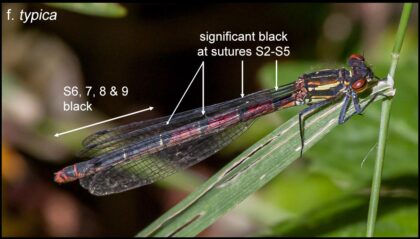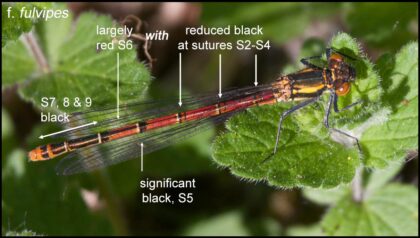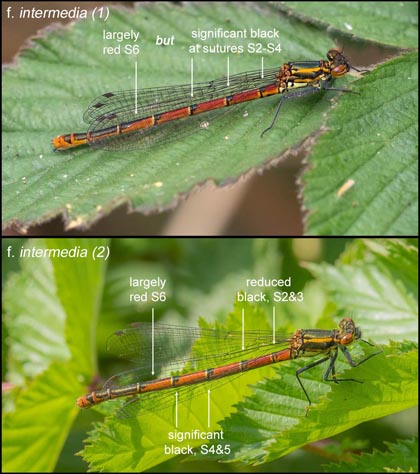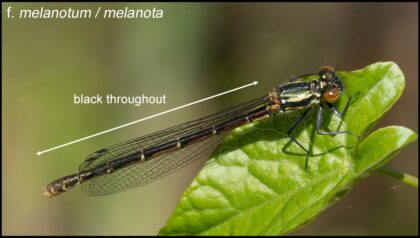It is generally considered that there are 3 female colour forms of Large Red Damselfly (Pyrrhosoma nymphula).
Or is it?
Beginning in 1988, R. R. (Dick) Askew is quite explicit in his seminal volume, The Dragonflies of Europe, which says:
There are three distinct female colour forms. The most abundant is the homeochrome typical form, coloured rather like the male but with a median black line on S2-6 which expands posteriorly into a spot on each of these segments. The intersegmental incisures [sutures] are yellow. Form fulvipes is very male-like with the mid-dorsal black line on the abdomen fine, and the apical black spots on S2-6 much reduced. The heterochrome form melanotum is very different from these homeochrome forms; the antehumeral stripes remain yellow throughout life and the abdomen is mainly bronze-black with the apex rust-coloured.
Askew does not assign a name, here, to “typical” though based on subsequent writings we might infer typica. [Regressing even further, this account matches that of Cynthia Longfield in The Dragonflies of the British Isles (1939).]
Thus, in increasing amounts of abdominal black we are given:
- fulvipes
- typical (typica)
- melanotum
However, this ostensibly simple picture gets clouded by more recent publications.
Our first cloud comes with the use of varying terminology. Though both volumes stick with 3 colour forms, Smallshire/Swash in Britain’s Dragonflies refer to typica whereas Brooks/Cham/Lewington, in Field Guide to the Dragonflies and Damselflies of Great Britain and Ireland instead refer to intermedia. So now typica and intermedia are looking like one and the same thing and we may now have:
- fulvipes
- typica or intermedia
- melanotum
Our second cloud comes courtesy of K-D Dijkstra in the 1st edition of his modern European classic, illustrated by the great Richard Lewington, Field Guide to the Dragonflies of Britain and Europe (2006), in which he says:
Various [?] female forms have been named but probably a wide range of intermediates exist.
Dijkstra continues:
The three main forms are (1) f. typica (f. intermedia is included here) … (2) f. fulvipes … (3) f. melanotum …
Wait a minute, that was 4 colour form names mentioned. Since, both within Dijkstra and Brooks/Cham/Lewington, melanotum is subdivided into two versions, one with some red and another with no red on the abdomen, we are actually here looking at 5 colour forms.
The nomenclature cloud doesn’t clear any when you notice that the relevant illustration in Dijkstra is labelled “f. typica” despite the text saying, “ f. intermedia is included here”. If anything the cloud thickens when you also note that the exact same Lewington illustrations used by Dijkstra in his European volume are also used in the Brooks/Cham/Lewington British Isles volume where the form labelled as “f. typica” by Dijkstra is labelled “f. intermedia” by Brooks/Cham/Lewington. In the latter there is no mention of “f. typica” whatsoever. Neither, in the British Isles volume, are the illustrations of its forms supported by any textual description.
Having introduced both typica and intermedia as co-existing, Dijkstra is completely silent, as far as I can see, on any distinction between them BUT this is the only publication where I can see 4 red colour form names used together though still with only 3 red-form diagrams.
However, I have received a description concerning intermedia versus typica, from Antoine van der Heijden in the Netherlands which, he thinks, may have come from the man himself, K-D Dijkstra:
intermedia should be anything “not perfectly typica and not perfectly fulvipes” as far as I understand and is thus quite common: a variation where S6 is NOT mostly black on top (like fulvipes) but where there IS a fat blob of black at the back of S2-6 (like typica) seems very common here [in the Netherlands].
So, let’s try and make sense of this form nomenclature confusion in pictures.
 I’ll begin with typica, it being a useful base line from which to gauge variations. “Perfectly typica” is characterized by having S6-S9 black, dorsally. It is S6 that becomes most significant in what follows. S2-S5 have sizeable black blobs at their posteriors. (This specimen is a particularly dark red individual, despite being not fully mature – yellow antehumerals – perhaps because it was taken at some altitude in the Pyrenees.)
I’ll begin with typica, it being a useful base line from which to gauge variations. “Perfectly typica” is characterized by having S6-S9 black, dorsally. It is S6 that becomes most significant in what follows. S2-S5 have sizeable black blobs at their posteriors. (This specimen is a particularly dark red individual, despite being not fully mature – yellow antehumerals – perhaps because it was taken at some altitude in the Pyrenees.)
 Now to address fulvipes. “Perfectly fulvipes“ is characterized by having S6 mainly red dorsally and by S2, S3 and S4 having greatly reduced black markings on their posteriors. Note that S5 retains its sizeable black blob. The reduced black markings of S2-S4 in fulvipes resemble pickaxe heads, to my eye.
Now to address fulvipes. “Perfectly fulvipes“ is characterized by having S6 mainly red dorsally and by S2, S3 and S4 having greatly reduced black markings on their posteriors. Note that S5 retains its sizeable black blob. The reduced black markings of S2-S4 in fulvipes resemble pickaxe heads, to my eye.
 So what, pray tell, might intermedia be? Well, intermedia would show some characteristics of fulvipes and some characteristics of typica: we’d see a fulvipes S6, mainly red dorsally, but with either no reduced black at the sutures of S2-S4 or with fewer than all three sutures showing reduced black; i.e. 0, 1 or 2 pickaxe heads but not 3 pickaxe heads (which would be “perfect fulvipes“).
So what, pray tell, might intermedia be? Well, intermedia would show some characteristics of fulvipes and some characteristics of typica: we’d see a fulvipes S6, mainly red dorsally, but with either no reduced black at the sutures of S2-S4 or with fewer than all three sutures showing reduced black; i.e. 0, 1 or 2 pickaxe heads but not 3 pickaxe heads (which would be “perfect fulvipes“).
I would suggest that this description of intermedia, red form females with varying strengths of black spots at the sutures, matches the great majority of those that I see locally but have previously been thinking of as fulvipes because of that red-topped S6.
My examples here seem to accord with Dijkstra’s suggestion that there is some sort of continuum existing in the largely red female forms, in which case assigning hard and fast names to varying amounts of black/red may be something of a moot point. There are extremes, which are those that tend to have been diagrammed in our familiar publications.
 Turning away from the largely red female forms, there is still, of course, melanotum, undisputedly all black along the abdomen dorsally, either with or without a hint of red. This form is not entirely undisputed, though. I have found at least one published opinion that the “no red” version of melanotum may simply not be fully mature. [I have never personally seen it.]
Turning away from the largely red female forms, there is still, of course, melanotum, undisputedly all black along the abdomen dorsally, either with or without a hint of red. This form is not entirely undisputed, though. I have found at least one published opinion that the “no red” version of melanotum may simply not be fully mature. [I have never personally seen it.]
For a final [?] twist of nomenclature, in his 2nd edition (2020) Dijkstra switches from melanotum to melanota for the largely black forms. I have a feeling that this may be for a linguistic binomial “gender agreement” reason.
It is Vol 26 of the Journal of the British Dragonfly Society (2010), in an article by Peter J. Mill then of Leeds University, that we see the doubt concerning the two sub-forms of melanotum:
There are three colour forms of female, all of which have narrow yellow rings at the anterior end of abdominal segments 2-7. The most common one, f. fulvipes, is similar in colouration to the male but also has black bands at the posterior end of abdominal segments 5 and 6 and the black on segments 7 and 8 is more extensive than in the male … In f. intermedia (f. typica) the black band on abdominal segment 6 extends the length of the segment and there are black bands at the posterior end of the first five abdominal segments … In f. melanotum the ante-humeral stripes are yellow and most of the dorsal surface of the abdomen is black; also the eyes are a duller red. In some specimens of this form the red on the abdomen is replaced by yellow …, although such individuals may not have achieved their final colouration.
Recognizing that this publication is 10 years old [at the time of writing], it is interesting for a number of reasons:
- it clearly regarded intermedia and typica as one and the same;
- it implied that the black atop S6 is key in distinguishing fulvipes from intermedia / typica;
- it suggested that fulvipes is the more common form and not intermedia / typica (as suggested by Askew);
- it questioned the 2nd no-red version of f. melanotum as a fully fledged adult form.
I now think, given a sensible-sounding description of differences between typica, fulvipes and a suggested form intermedia, and given my examples above, in increasing amounts of black, I can go with these female forms:
- fulvipes
- intermedia
- typica
- melanotum / melanota (avoiding “no red” issues)

[…] is something of a partner article to Large Red Females in that both Large Red Damselfly (Pyrrhosoma nymphula) and Small Red Damselfly (Ceriagrion […]